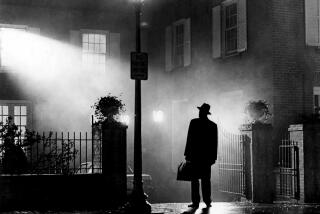Critic’s Pick: TV Picks: China, Iraq, Penn & Teller, space cartoon, comic space
“POV: Fallen City” (PBS, Monday); “Frontline: Losing Iraq” (PBS, Tuesday). Two hard-to-watch documentaries set across two separate seas, and each worth your while. I never promised this would just be fun.
“Losing Iraq,” which premieres this week on the PBS news series “Frontline” and features that series’ usual impressive mix of expert and first-person testimony, tracks the state of Iraq from the time of the 2003 invasion through its present descent into civil war — a state of national destabilization the United States undoubtedly did much to bring about and little to prevent; time after time, defeat was snatched from the jaws of victory. On the testimony here, much of the misadventure is due to people in power not listening to those closer to the situation — trusting their gut instead of intel or making foreign policy decisions to satisfy the necessities of American politics. It was Bush’s war, certainly, or the war that Donald H. Rumsfeld went out and got him, carried out on a false pretext and never thought through, but it’s plain to see also that President Obama’s desire to get out of Iraq left it wide open to trouble. Thoroughly depressing, but watch it anyway; there is a through-line there you may find useful to get a hold of, if only for your own sense of things, as the clock runs backward. From the team that brought you “The Lost Year in Iraq,” “The Torture Question,” “Endgame” and “Bush’s War” — so, you know.
Qi Zhao’s “Fallen City” is a different sort of story, set in the aftermath of a 2008 earthquake in Sichuan province that killed nearly 70,000 people and completely destroyed the river city of Beichuan. This is the story both of the fate of the city and some of its survivors: 14-year-old Hong, listless, missing his father (“He could help me fix some mental conflicts.... some man-to-man things”) and at war with his mother; Mr. and Mrs. Peng, whose 11-year-old daughter died in the collapse of her school; and Li Guihua, a middle-aged divorced woman living only to take care of her mother, paraplegic and unable to recognize her. (“I think I have seen through life already,” she says.) Qi, who arrived with a camera three days after the earthquake, follows his subjects over three years, in which time the town is both replaced and displaced, as the people of Beichuan take up residence in an orderly new high-rise city, proclaimed by the state “safe, beautiful and culturally rich,” but no place like home: “We used to live really close to one another,” says one, “but we can’t anymore.” And yet, though it goes to dark places — there are some surprising turns I won’t reveal because, really, watch it — it is a strangely beautiful film: intimate and individually human, connected to the land and to living things. It begins with water, and a leaf that reveals itself to be an insect lifting itself onto rock or rubble. “It’s only a small town in the mountains,” Hong will later say, looking over its remains, “but to me, it’s very grand.”
“Penn & Teller: Fool Us” (CW, Wednesdays). In an act of TV legerdemain, the CW transforms an old British series, already canceled, into a new American one. (Tonight’s premiere episode was originally broadcast in the UK in 2011 — you can date it nearly to the instant by host Jonathan “Wossy” Ross’ introduction of P&T as “quite simply the biggest thing to come out of Vegas since Charlie Sheen’s minibar bill.”) It is a contest, of sorts: Any magician who presents a trick that Penn and/or Teller cannot explain gets a free ride to and a stage appearance in the aforementioned Las Vegas. The ones they bust do not exactly have their secrets revealed; that would not only be bad form among conjurers but would also rob the contestants of their best illusions. Somehow they manage to convey that they know without saying what they know, revealing just enough to keep the game interesting from a formal standpoint. And they don’t always know. As one who has had illusions explained to him and still not understood how they were done, I sympathize, but that’s why I love magic. It is always smarter than me.
The contestants represent a range of approaches, from big-scale disappearing/reappearing acts (Penn: “I think it was about the time you pulled out the flag, Teller said, ‘Real girl in the box, he’ll be in the back’ ”) to the blindfolded dealing of a straight flush from a deck the duo supplied. (Penn again, since Teller doesn’t talk, much: “I have never seen anyone who did not do hard time in prison do that move you did … that well.” Which is to say, practice makes perfect.) Additionally, there is the vicarious gratification of seeing other people’s excellence recognized by experts. The CW also has a magical variety show, “Masters of Illusion,” coming Aug. 1, followed by Syfy’s “Wizard Wars” on Aug. 19, wherein magicians cook up illusions on the spot with unexpected materials; creator Rick Lax compares it to “Iron Chef,” but with prestidigitation. (And the really incredible thing here is that I spelled “prestidigitation” correctly without having to look it up.)
“Phineas and Ferb: Star Wars” (Disney Channel, Saturday). The first fruits of the Disney-Lucas synergy, or, if you prefer, the Monstro-like ingestion of the latter by the former. Rather as “Monty Python’s Life of Brian” followed a guy stumbling around in Jesus’ vicinity, this animated special is set alongside the events of “A New Hope,” the first and second-best “Star Wars” film. It does refer to the later and some of the later-earlier films, but the timeline runs from opening appearance of the Imperial Star Destroyer, down to Tatooine, through the Mos Eisley cantina and on to the Death Star, and so on through to the end. The cartoon characters find their place in the far-away galaxy: happy-go-lucky, mechanically gifted stepbrothers Phineas and Ferb, as Skywalker neighbors, in love with their hot, sandy planet; difficult older sister Candace, a storm trooper for the Empire; spunky, sparky Isabella a rival to Han Solo; foolish villain Dr. Doofenshmirtz a kind of Darth manque (he invented the Death Star as a nutcracker only to see his plans horribly enlarged); and Perry the Platypus, naturally, as a rebel spy.
They bustle about just around the corner from where the original movie takes place, occasionally interacting with its characters — animated with a sort of 1970s look, perhaps by intent — but also moving their own story forward. There are jokes, not for the first time in the joshing of science-fiction, that picture the unglamorous support staff needed to keep a Death Star running, working in cubicles, drinking black coffee. There are cracks about the lack of female characters and how fruit in a marketplace only ever has a short time to live in an action film, and the fact that the galaxy’s most dangerous weapon comes, basically, with “a self-destruct button — what kind of idiot would design that?” All the best “Star Wars” stories since halfway through “Jedi” have been cartoons, anyway, especially those that don’t take the movies too seriously — while of course taking them so seriously they can fill an hour with jokes about them.
“The Meltdown With Jonah and Kumail” (Comedy Central, Wednesdays). This tightly packed half-hour live comedy series is shot in the Nerdist Showroom out back of Meltdown Comics on Sunset Boulevard, one of the main stops on the L.A. Comedy Grand Tour. (It’s readable comics they sell out front, not the stand-up kind, though both might contain jokes.) Hosted by Jonah Ray (so great recently as an antagonistic record store clerk on “Maron” and Kumail Nanjiani, who is everywhere from “Adventure Time” to “Silicon Valley,” it has its relative ups and downs, which is to say everyone will like some of it more than they do … other of it, though probably none of it no one will not like at all. (Are we clear on that?) There is something different too about watching a thing like this as television, with its shifting point of view and angles back on the audience, than seeing it in person; live, all the attention in the room goes to a single spot (if the act is working). And you only see excerpts from what surely were longer sets, which would have had more room to breathe and build and establish and subvert a tone.
Still, it’s funny a lot and a useful guide to the range of styles and points of view available now in the very healthy comedy universe. Frequent cutaways to the green room, where comedians hang out and talk shop and trash and David Wain does card tricks for Eugene Mirman, work well; you could set a whole show backstage, really, without the pesky interruption of comics doing their actual acts. (Pete Holmes, cocking an ear toward the stage: “This is like a regular Meltdown show — Kumail and Jonah are doing a tight 45 up top — but don’t worry; it’s riffed.” This week’s edition features Emily Heller, Mirman, Jon Daly doing his strange Ryan Gosling impression (“I’m just a scared little boy in the body of an Adonis”), a singing Nick Offerman and T.J. Miller (Nanjiani’s “Silicon” costar) getting right down to it: “Do you guys think you’re good people?” he begins. “Everyone’s like — ‘Hold on. We have to decide now? I’m still working on some stuff.’” Producer Emily V. Gordon (who is married to Nanjiani) also appears, and Ben Stiller has a credit, and probably a cut.
Robert Lloyd is dead serious on Twitter @LATimesTVLloyd
More to Read
The complete guide to home viewing
Get Screen Gab for everything about the TV shows and streaming movies everyone’s talking about.
You may occasionally receive promotional content from the Los Angeles Times.






